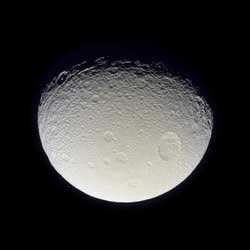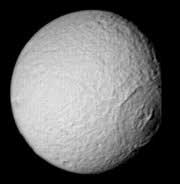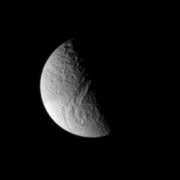.
Tethys (moon)
Tethys (tee'-this or teth'-is, Greek Τηθύς) is a moon of Saturn that was discovered by Giovanni Domenico Cassini in 1684.
| Tethys | |||||||
 |
|||||||
| Discovery | |||||||
|---|---|---|---|---|---|---|---|
| Discovered by | Giovanni Cassini | ||||||
| Discovered in | March 21, 1684 | ||||||
| Orbital characteristics | |||||||
| Semimajor axis | 294,619 km | ||||||
| Eccentricity | 0.000 [1] | ||||||
| Orbital period | 1.887802 d [2] | ||||||
| Inclination | 1.12° (to Saturn's equator) | ||||||
| Is a satellite of | Saturn | ||||||
| Physical characteristics | |||||||
| Mean diameter | 1059.8 km (1071.2×1056.4×1051.6 km) | ||||||
| Mass | 6.176×1020 kg | ||||||
| Mean density | 0.99 g/cm3 | ||||||
| Surface gravity | 0.16 m/s2 | ||||||
| Rotation period | synchronous | ||||||
| Axial tilt | zero | ||||||
| Albedo | 0.8 | ||||||
| Surface temp. |
|
||||||
| Atmosphere | none | ||||||
Name
Tethys is named after the titan Tethys of Greek mythology. It is also designated Saturn III.
It should not be confused with the asteroid 17 Thetis.
Cassini named the four moons he discovered (Tethys, Dione, Rhea and Iapetus) Lodicea Sidera ("the stars of Louis") to honour king Louis XIV. Astronomers fell into the habit of referring to them and Titan as Saturn I through Saturn V. Once Mimas and Enceladus were discovered, in 1789, the numbering scheme was extended to Saturn VII.
The names of all seven satellites of Saturn then known come from John Herschel (son of William Herschel, discoverer of Mimas and Enceladus) in his 1847 publication Results of Astronomical Observations made at the Cape of Good Hope ([3]), wherein he suggested the names of the Titans, sisters and brothers of Cronos (the Greek Saturn), be used.
The correct adjectival form of the moon's name is Tethyan, although other forms are also used.
Physical characteristics
Tethys is an icy body similar in nature to Dione and Rhea. The density of Tethys is 1.21 g/cm3, indicating that it is composed almost entirely of water-ice. The Tethyan surface is heavily cratered and contains numerous cracks caused by faults in the ice.
There are two different types of terrain found on Tethys, one composed of densely cratered regions and the other consisting of a dark colored and lightly cratered belt that extends across the moon. The light cratering of this second region indicates that Tethys was once internally active, causing parts of the older terrain to be resurfaced. The exact cause of the darkness of the belt is unknown but a possible interpretation comes from recent Galileo orbiter images of Jupiter's moons Ganymede and Callisto, both of which exhibit light polar caps that are made from bright ice deposits on pole-facing slopes of craters. From a distance the caps appear brighter due to the thousands of unresolved ice patches in small craters present there. The Tethyan surface may have been formed in a similar manner, consisting of hazy polar caps of unresolved bright ice patches with a darker zone in between.

Odysseus is the huge, shallow crater on the right
The western hemisphere of Tethys is dominated by a huge impact crater called Odysseus, whose 400 km diameter is nearly 2/5 of that of Tethys itself. The crater is now quite flat (or more precisely, it conforms to Tethys' spherical shape), like the craters on Callisto, without the high ring mountains and central peaks commonly seen on the Moon and Mercury. This is most likely due to the slumping of the weak Tethyan icy crust over geologic time.

Ithaca Chasma
The second major feature seen on Tethys is a huge valley called Ithaca Chasma, 100 km wide and 3 to 5 km deep. It runs 2000 km long, approximately 3/4 of the way around Tethys' circumference. It is thought that Ithaca Chasma formed as Tethys' internal liquid water solidified, causing the moon to expand and cracking the surface to accommodate the extra volume within. Earlier craters from before Tethys solidified were probably all erased by geological activity before then. There is another theory about the formation of Ithaca Chasma: when the impact that caused the great crater Odysseus occurred, the shockwave traveled through Tethys and fractured the icy, brittle surface on the other side. The Tethyan surface temperature is -187°C.
See also: List of geological features on Tethys.
The co-orbital moons Telesto and Calypso are located within Tethys' Lagrangian points L4 and L5, 60 degrees ahead and behind Tethys in its orbit respectively.
The Cassini orbiter performed a flyby of Tethys on September 23, 2005.
Tethys in fiction
An unnamed Tethys is the setting for the 1980 sci-fi thriller Saturn 3.
Links
... | Enceladus | Telesto, Tethys, Calypso | Polydeuces, Dione, Helene | ...
Saturn's natural satellites
Pan | Daphnis | Atlas | Prometheus | S/2004 S 6 | S/2004 S 4 | S/2004 S 3 | Pandora | Epimetheus and Janus | Mimas | Methone | Pallene | Enceladus | Telesto, Tethys, and Calypso | Polydeuces, Dione, and Helene | Rhea | Titan | Hyperion | Iapetus | Kiviuq | Ijiraq | Phoebe | Paaliaq | Skathi | Albiorix | S/2004 S 11 | Erriapo | Siarnaq | S/2004 S 13 | Tarvos | Mundilfari | S/2004 S 17 | Narvi | S/2004 S 15 | S/2004 S 10 | Suttungr | S/2004 S 12 | S/2004 S 18 | S/2004 S 9 | S/2004 S 14 | S/2004 S 7 | Thrymr | S/2004 S 16 | Ymir | S/2004 S 8
see also: Rings of Saturn | Cassini-Huygens | Themis
Retrieved from "http://en.wikipedia.org/"
All text is available under the terms of the GNU Free Documentation License

